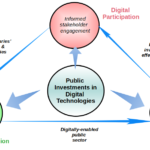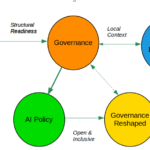KICG has been awarded USD 250,000 from GP IV funds to launch a programme on innovation. The latest version of the prodoc with comments from e-gov team members is here: ProDoc – Promoting open innovation.
In addition to the edited prodoc, I submitted the comments below as part of the virtual PAC.
1.This sort of initiative is indeed welcome in UNDP on a topic that, although nowadays is quite fashionable, UNDP needs to take head on if it wants to be make a real difference on the ground. Having said this, let me point to a few of the issues I see with the approach suggested
2. One core issues is the way the document handles innovation. Although in the text it seems to be talking about innovations in general (beyond technologies), the results framework does have a technological tilt. This should be clarified. Needless to say, if UNDP really wants to be innovative it should start with its own business processes, etc.. – and this is not just a technology issue.
3. The document does not take into account the recent shift in the innovation paradigm when it comes to new technologies. The Global South is taking the lead on this, a fact that is relevant to UNDP as social innovators in developing countries are in fact innovating to address local development issues and gaps. Just think about Kenya, Ghana, Philippines, Tunisia, etc. The document only looks at Northern based institutions working on innovation and to the WB.
4. This point is critical as it opens a different way of doing things for UNDP. First and foremost UNDP should keep and enhanced its policy and programming expertise which should not be affected by resources (funds and knowledge) being shifted to innovation projects, prototypes and experimentation. Second, as most developing countries already have network of social innovators, they can then be used to support the former while at the same time enhancing local and national capacities, etc.. So instead of “in-sourcing” all innovations UNDP can probably do best by also outsourcing wherever possible.
5. The document assumes that innovation is new to UNDP. This is not the case. Many of us have been working on innovations for many years and have learned a few things about this in UNDP. In many country offices we can find innovators who are doing very interesting stuff and supporting UNDP programmes. The project should try to make an effort to map all these efforts and on this basis create a true UNDP innovators network with champions in COs. This will make a big difference when it comes to the diffusion of innovations.
6. While on the topic of diffusion, the development theory of innovation, which has existed for almost 50 years, tells us that this is the critical aspect of any sort of innovation. Good ideas and good inventions will only make a difference if they can be diffused to a social structure or echo-system. Although the document mentions some of the elements required to make this happen, it should focus a bit more on how to ensure that innovations do diffuse across UNDP. The example of how TWs has diffused so far could be very illustrative here.
7. The document is weak when it comes to linking innovation to key programming and practice areas of UNDP. My team and I met a couple of weeks ago with the KICG team to share ideas, made this point and suggested that one of the outputs of the project should focus in supporting MAF efforts for example. The MAF explicitly calls for finding “accelerated solutions” to energize lagging MDG targets.
8. As a matter if fact, the document is ambivalent about this as it also tries to address corporate issues. Although related, the two are different and depend on different parameters. I will suggest (again) that initially these two area are keep separate to allow for more “disruptive” innovations on either side which could then “cross-pollinate” across the two. UNICEF has done this with some degree of success.
9. Let me end with a few tidbits:
“Innovation service lines”? I though we are getting rid of service lines.
Innovation as a end? It should be innovation for human development if anything.
“Start-up approach”? what are the institutional mechanisms that will allow this to happen in UNDP? where is the ¨venture capital¨ to support this?
Hope this helps.
Cheers, Raúl





